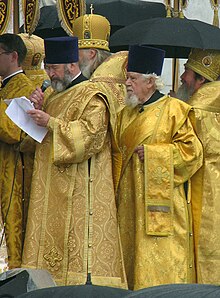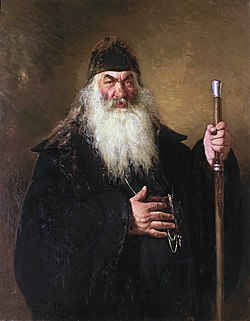Archdeacon
This articleneeds additional citations forverification.(January 2010) |

Anarchdeaconis a senior clergy position in theChurch of the East,Chaldean Catholic Church,Syriac Orthodox Church,Anglican Communion,St Thomas Christians,Eastern Orthodox churchesand some otherChristian denominations,above that of mostclergyand below abishop.In theHigh Middle Agesit was the most senior diocesan position below a bishop in theCatholic Church.An archdeacon is often responsible for administration within an archdeaconry, which is the principal subdivision of thediocese.TheOxford Dictionary of the Christian Churchhas defined an archdeacon as "A cleric having a defined administrative authority delegated to him by the bishop in the whole or part of the diocese."[1]The office has often been described metaphorically asoculus episcopi,the "bishop's eye".[2]
Catholic Church
[edit]In the LatinCatholic Church,the post of archdeacon, originally an ordained deacon (rather than a priest), was once one of great importance as a senior official of a diocese. The duties are now performed by officials such as auxiliary or coadjutor bishops, thevicar general,and theepiscopal vicars.The title remains.
History
[edit]The term "archdeacon" appears for the first time inOptatus of Mileve's history ofDonatismof about 370, in which he applies it to someone who lived at the beginning of that century. From the office of thediaconus episcopi,a deacon whom the bishop selected to administer the church's finances under the bishop's personal direction, the office of archdeacon gradually developed, as certain functions were reserved to him by law. These functions included not only financial administration but also the discipline of the clergy, and examination of candidates for priesthood. From the 8th century, there was in the West a further development of the authority of the archdeacon, who now enjoyed a jurisdiction independent of the bishop.
Large dioceses had several archdeaconries, in each of which the archdeacon (usually by now a priest), had an authority comparable to that of the bishop. He was often appointed not by the bishop but by thecathedral chapteror the king. However, from the 13th century, efforts were made to limit their authority. This was effected in part by the institution of the new office of vicar general. In 1553, theCouncil of Trentremoved entirely the independent powers of archdeacons. Those who had been in charge of different parts of the diocese gradually ceased to be appointed. Only the archdeacon associated with the cathedral chapter continued to exist as an empty title, with duties almost entirely limited to liturgical functions.[3][4]
The title of archdeacon is still conferred on acanonof various cathedral chapters,[5]and the word "archdeacon" has been defined in relation to the Latin Catholic Church as "a title of honour conferred only on a member of a cathedral chapter".[6]
However,Eastern Catholic Churches still utilize archdeacons.
Anglican Communion
[edit]Archdeacons serve the church in part of a diocese by taking particular responsibility for all buildings, the welfare of clergy and their families and the implementation of diocesan policy for the sake of the Gospel.[7]An archdeaconry is their territorial division; these vary in number according to the size of the diocese and in a few, mainly English, cases an assistant (Suffragan) Bishop will also stand in as Archdeacon, as applied to theArchdeaconry of Bodmin1953–62 (which is one of two archdeaconries in theDiocese of Truro). A later, possibly lasting instance, is in the role ofBishop suffragan(-Archdeacon) of Ludlow (inShropshire).
They are usually styledThe Venerableinstead of their usual clerical style ofThe Reverend.In theChurch of Englandthe role can only be held by a priest who has been ordained for at least six years. (This rule was introduced in 1840. The rule that they be in priests' orders was enacted in 1662.)[1]In the Church of England, the legal act by which a priest becomes an archdeacon is called acollation.If that archdeaconry is annexed to a canonry of the cathedral, they will also beinstalled(placed in a stall) at that cathedral, in practice working largely in the chapter offices.
In some other Anglican churches they can be deacons instead of priests; such archdeacons often work with the bishop to help with deacons' assignments to congregations and assist the bishop at ordinations and other diocesan liturgies. The Anglican ordinal presupposes (it is policy by default) that every Archdeacon helps to examine candidates for ordination and presents the most suitable candidate(s) to the ordaining bishop.[1]In some parts of the Communion where women cannot be consecrated asbishops,the position is the most senior office a female cleric can hold: this being so, for instance, in the(Anglican) Diocese of Sydney.[8]
Very rarely, "lay archdeacons" have been arisen, most notably the former Anglican Communion Observer to theUnited Nations,Taimalelagi Fagamalama Tuatagaloa-Leota,who retained her title after having served as Archdeacon ofSamoa.[citation needed]
Eastern Orthodox and Eastern Catholic churches
[edit]
In the Eastern Christian churches (Eastern Orthodox ChurchandEastern Catholic Churches), an archdeacon is the senior deacon within a diocese and has responsibility for serving at hierarchical services (those at which the bishop is present and presiding). He has responsibility for ensuring the smooth running of the service by directing the clergy and servers as appropriate. As such, he usually travels with the ruling bishop to various parts of the diocese, and will sometimes act as his secretary and cell attendant, ensuring that he is able to balance his monastic life with his hierarchical duties. The archdeacon wears the doubleorarion,which is twice the length of the usual orarion, and wraps under the right arm as well as hanging from the left shoulder. An archdeacon may come from either the monastic or married clergy.
A protodeacon also wears the double orarion, although he is distinguished from the archdeacon in that he is the senior deacon at a cathedral or other principal church within a diocese and serves as the principal deacon when a number of deacons serve together.
Saint Thomas Christians
[edit]This sectionneeds additional citations forverification.(July 2019) |
According to the canons of the Eastern churches, an archdeacon is of the highest priestly rank: he is the head of all the clerics belonging to a bishopric; he is responsible for the whole worship of the cathedral church and represents the will of the bishop in his absence. However, from the local point of view, the rank of an archdeacon was more important than this; not only was he the most important priest of the community, but he also fulfilled the role of anethnarch.An archdeacon was the "prince and head of the Christians of Saint Thomas" and had such titles as "Archdeacon and Gate of All India, Governor of India". The origin and the meaning of the term "gate" is mysterious. While the Catholicos Patriarch of Seleucia-Ctesiphon reserved for himself the right to send his own prelates originating from Iraq to the Indian diocese, the continuous governance of his Indian flock was secured by the indigenous Archdeacon serving as the head of all the priests in Malabar and representing the bishop's will.
According to the traditional structure, the Indian Church of the East was governed by a metropolitan sent by the Catholicos Patriarch. At the same time, at the local level, in India, church affairs were governed by the Malabar Assembly orMalankara Yogam.There was also an indigenous head of the Church of Malabar, the "head of the caste", that is the head of the St Thomas Christians calledJathikku KarthavyanorMalankara Mooppen[citation needed].Patriarch Timothy (780–826) of Persia called him the head of the faithful in India.
While originally an archdeacon in the Church of the East was elected by the bishop according to merit, the office of the Archdeacon of India seems to have been dynastic. It was the privilege of the Pakalomattam family, at least from the sixteenth century onwards. Indeed, we know about a number of Pakalomattam archdeacons, beginning with 1502, when Metropolitan John of India appointed George Pakalomattam. The name of the family varies, and the family seems to be identical with the Parambil family, translated into Portuguese as 'de Campo'.
An archdeacon had all the attributes of a secular leader and was normally escorted by a number, sometimes several thousands, of soldiers. While there could be several bishops appointed for the Malabar Church, there was always only one archdeacon, a custom contrary to the canons of the Church of the East. This situation is best explained by the fact that from the point of view of theEast SyriacChurch structure the archdeacon had an ecclesiastical function, but from that of the St Thomas Christian community he had also a socio-political, princely function, representing the unity of the Christian nation, or caste(s), of Hindoo (India). Portuguese colonists stopped this practice among theSyro-Malabar Catholicand Pulikkottil Mar Dionysious stopped this amongst theMalankara Syrian Churchlater in 1816.
Coptic Christians
[edit]In theCoptic Orthodoxchurch, an archdeacon is the highest rank in the order of deacons.[9]The lower ranks of the diaconate aredeacon,subdeacon,lectorandcantor,the holders of which ranks the Coptic people generically refer to as "deacons". However, the rank of archdeacon is lower than the rank of apriest.[10]Thus it is possible for adeaconto be appointed to the rank of an archdeacon within the Coptic Orthodox tradition.
See also
[edit]- Church of England § Structure
- Superintendent (Christianity),an analogous position in some Christian denominations
References
[edit]- ^abcCross, FL, ed. (1957),The Oxford Dictionary of the Christian Church,London: Oxford University Press, p. 79.
- ^"VI. Church",Medieval History,vol. I, Third millennium library, archived fromthe originalon February 10, 2011
- ^Johann Peter Kirsch, "Archdeacon"inCatholic Encyclopedia(New York 1907)
- ^"Archdeacon" inEncyclopædia Britannica1911
- ^Diocese of Limerick: Chapter of Limerick
- ^Dictionary, based on Random House Dictionary
- ^"The chapter".Gloucester cathedral. Archived fromthe originalon 2012-03-25.Retrieved2012-03-30.
- ^"Archdeacon Narelle Jarrett"(profile).Anglican Diocese of Sydney.Retrieved8 June2012.
- ^"The Ranks of the Deaconate".St. Mary & St. Shenouda's Coptic Orthodox Church, South London.Retrieved25 February2017.
- ^"THE SACRAMENT OF PRIESTHOOD".St. Mark Coptic Church, Jersey City, NJ.Retrieved25 February2017.
External links
[edit]- Role of Archdeacons, the tomb of Archdeacons and Kappalottam at Kuravilangadu,Nasrani, 2007-06-14.
- The Saint Thomas Christians in India from 52 to 1687 AD,DE:Srite, archived fromthe originalon 2021-07-11,retrieved2009-11-09.
- Bibliography of Works relevant to Archdeacons throughout Europe,CA:U Toronto, archived fromthe originalon 2007-11-17.
- Phillips, Walter Alison(1911)..Encyclopædia Britannica.Vol. 2 (11th ed.). pp. 358–359.
- Pakalomattom Ayrookuzhiyil family,archived fromthe originalon 2011-06-24,retrieved2013-01-28.

